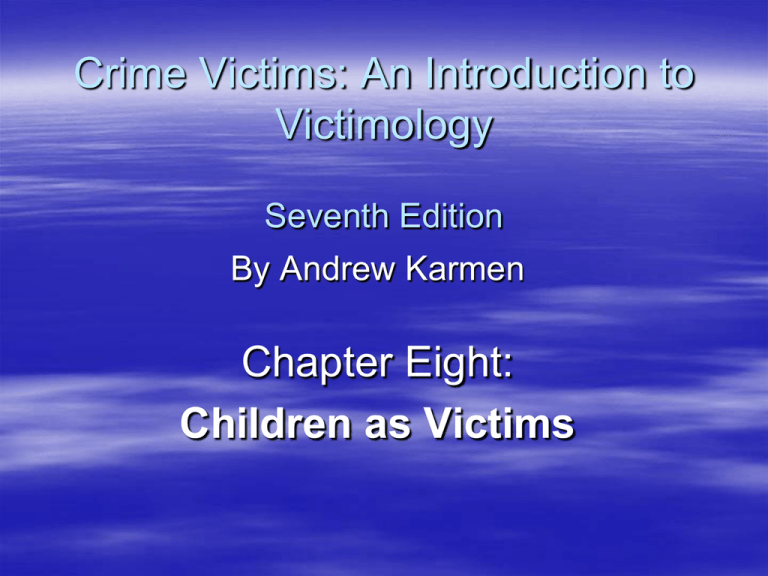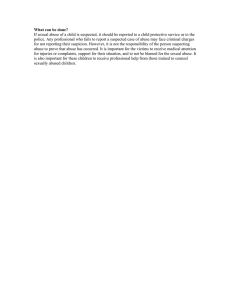
Crime Victims: An Introduction to
Victimology
Seventh Edition
By Andrew Karmen
Chapter Eight:
Children as Victims
Children as Victims
Maximalist vs. Minimalist Positions
– Debate continues with no real statistical data
Maximalist
Overlooked problem reaching epidemic
proportions
Wide problem not receiving adequate attention
Must mobilize people to combat growing crisis
Children as Victims
Minimalist
– Skeptical of scope and seriousness
– Attention and expenditures not warranted
Minimalists’ and Maximalists’ viewpoints are
ideologies
Individuals of these categories are considered
alarmists (Maximalists) or skeptics (Minimalists)
Missing Children
Kidnapping need not involved force
or violence to be illegal
Inveiglement—detainment through trickery
or manipulation
– Kidnapping
– For ransom
– For sexual abuse
– Raise as their own child
– To kill
Missing Children
See Box 8.1, page 197: Highlights of the
Rediscovery of the Missing Children
Problem
No real data on “Kidnapping”
– Not even a Part 1 Crime under UCR
– NCVS does not include crimes against children
under age 12
Missing Children
1984 National Incidence Study of Missing,
Abducted, Runaway and Throwaway
(NISMART) established to gather data
– See Box 8.2, page 200
– 90-115 Life-Threatening Kidnappings per Year
– 12,000 Short-Term Abductions by Non-Family
Member per Year
– 56,500 Long-Term Abductions by Family
Member per Year
Missing Children
NISMART 2 study of over 800,000 cases
reported to police:
– 45% runaways or throwaways
– Throwaway: child turned out of the house by
parents
– 43% misunderstandings and miscommunication
between child and parents
– 8% did not return home due to lost/injured
Missing Children
National Responses to Problem
– “Be On the Look Out” (BOLO)
– Code Adam
– Amber Alert
– Stranger Danger
– Family Secret Words
– Stockholm Syndrome Challenges
Physically and Sexually Abused
Children
Battered Child Syndrome—cyclical pattern of
excessive force perpetrated by parents who
themselves were abused
Neglect—abandoned or failed to provide basic
requirements
– Physical, Emotional, Educational
Physical Abuse—Physical force to extended
confinement
Sexual Abuse—Incest, fondling, sodomy,
intercourse, rape and exploitation (pornography
and prostitution)
Child Abuse
Private Survey
– 60% of 2-parent families experience violence
– 38% of girls molested
– 31% of boys sexually molested
– 1% raped by father or grandfather
Child Abuse
Maximalist Position
– Occurring in enormous numbers—not reported
– Under-reporting serious problem
– Professionals, teachers, counselors not
reporting
– Cases reported not followed up on due to lack
of resources
Child Abuse
Minimalist Position
– Definition of child abuse expanding—
slaps and spanking included
– “Abuse” now includes “normal discipline”
– Events not increasing—Reporting
increasing
– Unproven allegations should not be
counted
– Media have sensationalized occurrences
Child Abuse
Trends of 70s–90s saw increased events
Ebbed in late 90s and now decreasing
2001: Rates of “very serious violence”
dropped from 36/1000 to 19/1000— almost
a 50% decrease!
Drugs and alcohol are factors contributing to
child abuse
Child Sex Abuse Continued
SAID Syndrome—”Sexual Allegations in
Divorce”
Repressed Memories of Children—False
Memory (Pseudomemories) coined by
Sigmund Freud
Sex Abuse by Clerics
Satanic Cults
Abused Children and Legal
Proceedings
Prevention of further abuse in CJ system
Guardian Ad Litem (GAL)—Child Advocate
Two ways to view abusers:
– 1. View the parental wrong as
dysfunctional and in need of help
– 2. View them as criminals deserving
punishment
Children as Witnesses
Two Points of View
– Pro-prosecution/Pro-victim—Children generally
competent on fairly recent events.
– Pro-Defendant—Questions trustworthiness as
vulnerable to coaching by adults. High pressure
techniques can lead to false memory and
ultimately lead to false conviction.
Children as Witnesses
Wheeler vs. US (1895): children under 14
had to pass competency before testifying
Child Abuse Act of 1990 ruled all children
competent unless evidence to contrary
Child Friendly Courtrooms/Practices
1990 US Supreme Court (Maryland vs.
Craig) ruled alternatives permissible
– Hearsay Rule exceptions, use of dolls, etc.
Child Abuse
Funnel Model of Criminal Justice System
– So many cases are weeded out at various
stages, that very few cases remain in which the
child testifies and parents are convicted
– Pro-active vs. Re-active Strategies
What is the proper role of Government?
Who do children belong to?
Who is responsible for them?
Additional Forms of Exploitation of
Children
Sibling Abuse
Abuse of Adolescents by Parents
Statutory Rape of Minors
Key Terms
Maximalist
Minimalist
Throwaways
Missing Children
Code Adam
Amber Alert
Child Lures
Cruelty to Children
House of Refuge
Movement
Incidence
Prevalence
Battered Child
Syndrome
Unfounded Reports
Funnel Model
SAID syndrome
Pseudomemories
Guardian ad litem
GAL
Inveiglement




